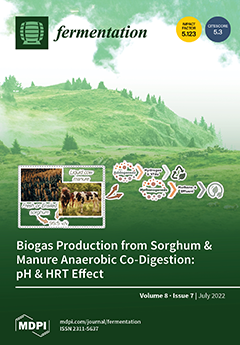This study aimed at characterizing changes in rumen bacteria abundance and fermentation profiles by artificial saliva (AS) pH, and at evaluating the potential modulatory role of
Aspergillus oryzae culture (AOC) in a rumen simulation technique (RUSITEC) system. The treatment included high AS pH (pH 6.8) or low AS pH (pH 5.5) according to the McDougall’s method, and low AS pH was sustained by changing the composition of the AS (NaHCO
3 from 9.8 to 1.96 g/L, Na
2HPO
4 from 9.3 to 1.86 g/L). In low AS pH condition, the diets contained either 0% AOC, 1.25% AOC, or 2.5% AOC. Therefore, there are four treatments: (1) high AS pH, 0% AOC (HASP); (2) low AS pH, 0% AOC (AOC0); (3) low AS pH, 1.25% AOC (AOC1); (4) low AS pH, 2.5% AOC (AOC2), respectively. The experimental diets were supplemented with 16 g basic diets with the forage to concentrate ratio of 40:60. The experiments were conducted two independent 13 days, with 9 days adaption periods and 4 days sample collection. The results showed that low AS pH decreased the degradabilites of dry matter (DM), organic matter (OM), crude protein (CP), neutral detergent fiber (NDF), and acid detergent fiber (ADF) (
p < 0.05), which occurred due to a decreased abundance of fibrolytic
Ruminococcus albus (
p < 0.001). The total concentration of volatile fatty acid (VFA) and proportion of propionate were decreased in the low AS pH (
p = 0.026) and tended to increase the molar proportion of butyrate (
p = 0.086) and the ratio of acetate to propionate (
p = 0.088). The abundances of phylum
Firmicutes (
p = 0.065) and
Proteobacteria (
p = 0.063) tended to be greater in low AS pH group than high AS pH group. Low AS pH increased the abundance of phylum
Actinobacteria (
p = 0.002) compared to the high AS pH and decreased the abundances of phylum
Spirochaetes (
p = 0.032). Compared with the high AS pH, low AS pH increased the abundances of
Prevotella (
p = 0.003),
Pseudoscardovia (
p = 0.001),
Mitsuokella (
p = 0.005), and
Dialister (
p = 0.047), and decreased the abundances of
Olivibacter (
p = 0.026),
Ruminobacter (
p = 0.025),
Treponema (
p = 0.037), and
Sphaerochaeta (
p = 0.027) at genus level. Under a severe SARA in RUSITEC, supplementation of 2.5% AOC increased OM degradability, the copy numbers of
Selenomonas ruminantium and
Fibrobacter succinogenes. These findings indicate that the reduction AS pH at 5.5 caused a strong shift in bacterial composition in rumen. In addition, the addition of AOC in diets increased the growth rate of certain rumen bacteria that digest fiber or utilize lactate under SARA condition in RUSITEC system.
Full article





